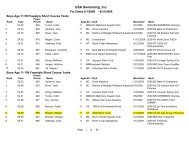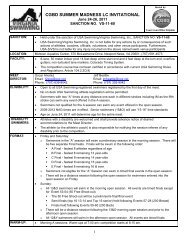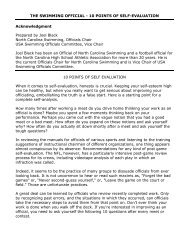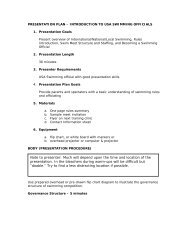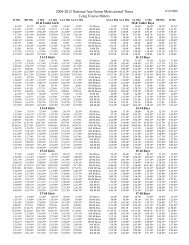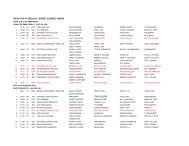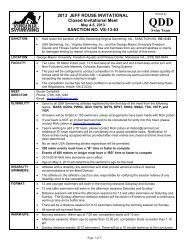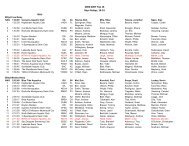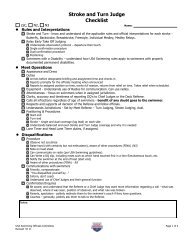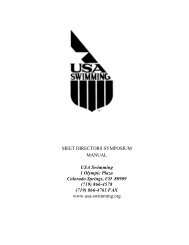VSI S&T Judge Certif.. - Virginia Swimming
VSI S&T Judge Certif.. - Virginia Swimming
VSI S&T Judge Certif.. - Virginia Swimming
You also want an ePaper? Increase the reach of your titles
YUMPU automatically turns print PDFs into web optimized ePapers that Google loves.
Stroke & Turn <strong>Judge</strong><br />
<strong>Certif</strong>ication Clinic
Stroke & Turn <strong>Judge</strong><br />
<strong>Certif</strong>ication Clinic<br />
• <strong>Certif</strong>ication Requirements<br />
• Philosophy of Officiating<br />
• The Rules<br />
– Video<br />
– Common Infractions<br />
• Assignment and Jurisdiction of Officials<br />
• Stoke & Turn <strong>Judge</strong> Procedures<br />
• Test
Handouts and Forms<br />
• Copy of certification requirements<br />
• Training cards<br />
• Forms (DQ slip, relay take-off slip)<br />
• Recommended stroke briefing<br />
• Recommended jurisdiction<br />
• Non-athlete registration form
S&T <strong>Judge</strong> <strong>Certif</strong>ication<br />
Requirements (Summary)<br />
• <strong>Certif</strong>ied as a Timer<br />
• Attend training clinic<br />
• Pass written test<br />
• Must join USA <strong>Swimming</strong>/<strong>VSI</strong> and display<br />
registration card while on deck<br />
• Complete six training sessions (not in white &<br />
blue) and predominantly at B/C meets<br />
• Satisfactorily work an additional two sessions<br />
(with B/C swimmers) with an assigned trainer<br />
and make calls (in white & blue)
S&T <strong>Judge</strong> <strong>Certif</strong>ication<br />
Requirements Cont’d<br />
• <strong>Certif</strong>ied for one-year probationary period<br />
• Upon satisfactory completion of the one<br />
year probationary period, re-certified for a<br />
one year period (ending in December)<br />
• Must work a minimum of 8 sessions per<br />
year to re-certify
Philosophy of Officiating<br />
“All competitive swimming events held<br />
under USA <strong>Swimming</strong> sanction shall be<br />
conducted in accordance with the following<br />
rules which are designed to provide fair and<br />
equitable conditions of competition and<br />
promote uniformity in the sport so that no<br />
swimmer shall obtain unfair advantage over<br />
another.”<br />
Preamble to the USA-S Technical Rules
Fair and Equitable<br />
• Judging should be consistent among<br />
different officials at a meet<br />
• Judging should be consistent at<br />
different meets<br />
• All of the rules are enforced, we don’t<br />
individually choose to enforce some<br />
rules and ignore others
Fair and Equitable Cont’d<br />
• The rules are enforced across all age<br />
groups and levels of ability<br />
• Officials should be neutral in their<br />
enforcement of the rules; don’t favor<br />
one team over another, don’t favor one<br />
swimmer over another
Mental Traps<br />
• Advantage vs. disadvantage<br />
• The “twice theory”<br />
• “We don’t disqualify 8 & unders”<br />
• “Don’t ask me to judge my child”<br />
• Don’t infer (Call what you see, not what<br />
you don’t see)
Rules of Thumb<br />
• The benefit of the doubt ALWAYS goes<br />
to the swimmer<br />
– No loss of yardage, foul shots, penalty box<br />
Black<br />
Grey<br />
White<br />
Illegal Legal Legal
Rules of Thumb Cont’d<br />
• Ugly ain’t (necessarily) illegal<br />
• Know the rules; review the rules before<br />
meets<br />
• Experience, experience, experience
Officiating <strong>Swimming</strong> Video<br />
• Clear and consistent knowledge of the rules<br />
• Clarify proper interpretation of the rules as<br />
they pertain to the most common<br />
disqualification calls made (in italics in<br />
following slides)<br />
• Following slides give representative, but not<br />
comprehensive, examples of rules violations
USA <strong>Swimming</strong> Video<br />
•Video Link
Butterfly Rules<br />
101.3 BUTTERFLY<br />
.1 Start — The forward start shall be used.<br />
.2 Stroke — After the start and after each turn, the swimmer’s shoulders must<br />
be at or past the vertical toward the breast. The swimmer is permitted one or<br />
more leg kicks, but only one arm pull under water, which must bring the<br />
swimmer to the surface. It shall be permissible for a swimmer to be completely<br />
submerged for a distance of not more than 15 meters (16.4 yards) after the start<br />
and after each turn. By that point, the head must have broken the surface. The<br />
swimmer must remain on the surface until the next turn or finish. From the<br />
beginning of the first arm pull, the body shall be kept on the breast. Both arms<br />
must be brought forward over the water and pulled back simultaneously.<br />
.3 Kick — All up and down movements of the legs and feet must be<br />
simultaneous. The position of the legs or the feet need not be on the same level,<br />
but they shall not alternate in relation to each other. A scissors or breaststroke<br />
kicking movement is not permitted.<br />
.4 Turns — At each turn the body shall be on the breast. The touch shall be<br />
made with both hands simultaneously at, above, or below the water surface.<br />
Once a touch has been made, the swimmer may turn in any manner desired.<br />
The shoulders must be at or past the vertical toward the breast when the<br />
swimmer leaves the wall.<br />
.5 Finish — At the finish, the body shall be on the breast and the touch shall be<br />
made with both hands simultaneously at, above, or below the water surface.
Butterfly Infractions<br />
• Not at or past vertical towards the breast after the<br />
start and after each turn<br />
• Head not up at 15 meters<br />
• More than 1 underwater pull<br />
• Non-simultaneous pull or arm recovery<br />
– Need not be symmetrical<br />
• Arms not recovered over the surface of the water<br />
– The arm is anything above the wrist and below the<br />
shoulder<br />
– Looking for any part of the arm to break the water<br />
surface
Butterfly Infractions Cont’d<br />
• Upward or downward movements of the legs<br />
not simultaneous<br />
• Legs or feet alternate in relationship to each<br />
other<br />
– Legs and feet do not have to be on the same level<br />
• A scissors or breaststroke kicking movement<br />
• Not on the breast during swim<br />
• One hand or non-simultaneous touch at turns<br />
or finish
Backstroke Rules<br />
101.4 BACKSTROKE<br />
.1 Start — The swimmers shall line up in the water facing the starting end, with<br />
both hands placed on the gutter or on the starting grips. Standing in or on the<br />
gutter, placing the toes above the lip of the gutter, or bending the toes over the<br />
lip of the gutter, before or after the start, is prohibited.<br />
.2 Stroke — The swimmer shall push off on his back and continue swimming on<br />
the back throughout the race. Some part of the swimmer must break the surface<br />
of the water throughout the race, except it is permissible for the swimmer to be<br />
completely submerged during the turn, at the finish and for a distance of not<br />
more than 15 meters (16.4 yards) after the start and after each turn. By that<br />
point, the head must have broken the surface of the water.<br />
.3 Turns — Upon completion of each length, some part of the swimmer must<br />
touch the wall. During the turn the shoulders may be turned past the vertical<br />
toward the breast after which a continuous single arm pull or a continuous<br />
simultaneous double arm pull may be used to execute the turn. The swimmer<br />
must have returned to a position on the back upon leaving the wall.<br />
.4 Finish — Upon the finish of the race, the swimmer must touch the wall while<br />
on the back.
Backstroke Infractions<br />
• Not on the back throughout race<br />
• Head not up at 15 meters<br />
• Non-continuous turning motion<br />
• Failing to touch the wall at the turn<br />
• Shoulders not past vertical toward the back<br />
prior to leaving the wall<br />
• Toes curling over the gutter after the starting<br />
signal (before the starting signal is the<br />
Starter’s responsibility)
Backstroke Infractions Cont’d<br />
• A poorly executed turn in which the swimmer<br />
turns too close to the wall and who’s hand(s)<br />
contact the wall rather than continuing<br />
through the flipping motion is legal as long it<br />
was a continuous turn up to the point at<br />
which contact with the wall was made.
Backstroke Infractions Cont’d<br />
Judging an underwater finish:<br />
• If the swimmer completely submerges prior<br />
to the Turn <strong>Judge</strong> having to shift his/her<br />
attention to the touch at the wall, this would<br />
be a DQ.<br />
• Once the Turn <strong>Judge</strong> shifts his/her attention<br />
to watching the touch at the finish, it is then<br />
legal for the swimmer to be fully submerged.
Breaststroke Rules<br />
101.2 BREASTSTROKE<br />
.1 Start — The forward start shall be used.<br />
.2 Stroke — From the beginning of the first arm stroke after the start<br />
and after each turn, the body shall be kept on the breast. It is not<br />
permitted to roll onto the back at any time. Throughout the race the<br />
stroke cycle must be one arm stroke and one leg kick in that order. All<br />
movements of the arms shall be simultaneous and in the same<br />
horizontal plane without alternating movement. The hands shall be<br />
pushed forward together from the breast on, under, or over the water.<br />
The elbows shall be under water except for the final stroke before the<br />
turn, during the turn and for the final stroke at the finish. The hands<br />
shall be brought back on or under the surface of the water. The hands<br />
shall not be brought back beyond the hip line, except during the first<br />
stroke after the start and each turn. During each complete cycle, some<br />
part of the swimmer’s head shall break the surface of the water. After<br />
the start and after each turn, the swimmer may take one arm stroke<br />
completely back to the legs. The head must break the surface of the<br />
water before the hands turn inward at the widest part of the second<br />
stroke.
Breaststroke Rules Cont’d<br />
.3 Kick — After the start and each turn, a single downward butterfly<br />
kick followed by a breaststroke kick is permitted while wholly<br />
submerged. Following which, all movements of the legs shall be<br />
simultaneous and in the same horizontal plane without alternating<br />
movement. The feet must be turned outwards during the propulsive<br />
part of the kick. A scissors, flutter or downward butterfly kick is not<br />
permitted except as provided herein. Breaking the surface of the water<br />
with the feet is allowed unless followed by a downward butterfly kick.<br />
.4 Turns and Finish — At each turn and at the finish of the race, the<br />
touch shall be made with both hands simultaneously at, above, or<br />
below the water level. The head may be submerged after the last arm<br />
pull prior to the touch, provided it breaks the surface of the water at<br />
some point during the last complete or incomplete cycle preceding the<br />
touch.
Breaststroke Infractions<br />
• Cycle must start with a pull, starting with a kick is illegal<br />
• Hands brought beyond the hip line, except for the first<br />
stroke after the start and after each turn<br />
• Head does not break the surface during each complete<br />
or incomplete cycle<br />
• Arms not pulling in the horizontal plane, including the<br />
first pull following each turn<br />
• Non-simultaneous pull<br />
• Elbows not remaining in contact with the water during<br />
the recovery (forward) portion of the stroke except for<br />
the last stroke before the turns and finish (does not<br />
apply to the backwards pull)
Breaststroke Infractions Cont’d<br />
• One hand or non-simultaneous touch at turns or finish<br />
• Not past vertical towards the breast from the beginning<br />
of the first arm pull after the start and after each turn<br />
• Feet not turned outward during the propulsive phase of<br />
the kick<br />
• Non-simultaneous kick<br />
• A scissors, flutter, or butterfly kick
Breaststroke Infractions Cont’d<br />
• Looking for the butterfly kick in breaststroke<br />
– It is a legal kick if the feet are following the hips as<br />
the knees pull them forward.<br />
– The position of the feet is key to judging the<br />
breaststroke kick:<br />
• If the toes are pointed outward during the<br />
propulsive phase of the kick, it is a legal<br />
breaststroke kick.<br />
• If the toes are pointed straight back or inwards,<br />
it is a butterfly kick.
Breaststroke Infractions Cont’d<br />
– It is not unusual for a swimmer to have a<br />
significant undulating motion which may result in<br />
the feet breaking the surface of the water which<br />
may result in a “rooster tail” of spray as they begin<br />
the recovery phase of their kick. This is not illegal<br />
unless accompanied by a downward butterfly kick.<br />
– It is not unusual for strong swimmers to push a<br />
wave of water under their bodies during the first<br />
pull which results in their legs rising up and downthis<br />
is also not illegal.<br />
– Remember, this can sometimes be a difficult call<br />
to make and the benefit of the doubt always goes<br />
to the swimmer.
Breaststroke Infractions Cont’d<br />
• Rules and Regulations Committee Interpretations<br />
– Clarified that, in conformance with FINA’s intent,<br />
the requirement for the elbows to remain under<br />
the water on the breaststroke applies only to the<br />
recovery (forward) portion of the arm stroke, not<br />
to the backwards pull.<br />
– Agreed that the breaststroke must start with an<br />
arm pull to comply with the cycle of “one arm<br />
stroke and one leg kick, in that order” as stated in<br />
the rule. A swimmer starting with a leg kick first<br />
would be disqualified.<br />
– Reiterated that, under the March 6, 1998 rule<br />
changes by FINA, the arms must be in the same<br />
horizontal plane during the first pull at the start<br />
and after each turn.
Breaststroke<br />
• 2005 Breaststroke rule change:<br />
• Breaststroke Video
Freestyle Rules<br />
101.5 FREESTYLE<br />
.1 Start — The forward start shall be used.<br />
.2 Stroke — In an event designated freestyle, the swimmer may swim<br />
any style, except that in a medley relay or an individual medley event,<br />
freestyle means any style other than butterfly, breaststroke or<br />
backstroke. Some part of the swimmer must break the surface of the<br />
water throughout the race, except it shall be permissible for the<br />
swimmer to be completely submerged during the turn and for a<br />
distance of not more than 15 meters (16.4 yards) after the start and<br />
each turn. By that point the head must have broken the surface.<br />
.3 Turns — Upon completion of each length the swimmer must touch<br />
the wall.<br />
.4 Finish — The swimmer shall have finished the race when any part of<br />
his person touches the wall after completing the prescribed distance.
Freestyle Rules<br />
101.5 FREESTYLE<br />
.1 Start — The forward start shall be used.<br />
.2 Stroke — In an event designated freestyle, the swimmer may swim<br />
any style, except that in a medley relay or an individual medley event,<br />
freestyle means any style other than butterfly, breaststroke or<br />
backstroke. Some part of the swimmer must break the surface of the<br />
water throughout the race, except it shall be permissible for the<br />
swimmer to be completely submerged during the turn and for a<br />
distance of not more than 15 meters (16.4 yards) after the start and<br />
each turn. By that point the head must have broken the surface.<br />
.3 Turns — Upon completion of each length the swimmer must touch<br />
the wall.<br />
.4 Finish — The swimmer shall have finished the race when any part of<br />
his person touches the wall after completing the prescribed distance.
Freestyle Infractions<br />
• Head not up at 15 meters<br />
• Walking on or pushing off the bottom<br />
• Using the lane line or gutter for<br />
propulsion<br />
• Failing to touch the wall at the turn
Individual Medley Rules<br />
101.6 INDIVIDUAL MEDLEY — The swimmer shall swim the prescribed distance in the following<br />
order: the first one-fourth, butterfly; the second one-fourth, backstroke; the third one-fourth,<br />
breaststroke; and the last one-fourth, freestyle.<br />
.1 Start — The forward start shall be used.<br />
.2 Stroke — The stroke for each one-fourth of the designated distance shall follow the prescribed<br />
rules for that stroke.<br />
.3 Turns<br />
A. Intermediate turns within each stroke shall conform to the turn rules for that stroke.<br />
B. The turns when changing from one stroke to another shall conform to the finish rules for the<br />
stroke just completed, and shall be as follows:<br />
(1) Butterfly to backstroke — The swimmer must touch as described in 101.3.5. Once a<br />
legal touch has been made, the swimmer may turn in any manner, but the shoulders must<br />
be at or past the vertical toward the back when the swimmer leaves the wall.<br />
(2) Backstroke to breaststroke — The swimmer must touch the wall while on the back.<br />
Once a legal touch has been made, the swimmer may turn in any manner but the<br />
shoulders must be at or past the vertical toward the breast when the swimmer leaves the<br />
wall and the prescribed breaststroke form must be attained prior to the first arm stroke.<br />
(3) Breaststroke to freestyle — The swimmer must touch as described in 101.2.4. Once<br />
a legal touch has been made, the swimmer may turn in any manner.<br />
.4 Finish — The swimmer shall have finished the race when any part of his/her person touches the<br />
wall after the prescribed distance.
Individual Medley Infractions<br />
• Strokes not swum in proper order<br />
• Violation of stroke and turn rules for<br />
each stroke<br />
• The last ¼ of the race must be swum as<br />
something other than butterfly,<br />
backstroke, or breaststroke
Individual Medley Infractions Cont’d<br />
• Violation of finish rules at the transition<br />
between strokes<br />
– Butterfly to backstroke flip turn is illegal<br />
only if you see the hands not touch (not<br />
the same as not seeing them touch)<br />
– Backstroke to breaststroke cross-over turn<br />
is illegal only if their lead hand does not<br />
contact the wall before their shoulders go<br />
past vertical towards the breast as they<br />
make the turn
Relay Rules<br />
101.7 RELAYS<br />
.1 Freestyle Relay — Four swimmers on each team,<br />
each to swim one-fourth of the prescribed distance<br />
using any desired stroke(s). Freestyle finish rules apply.<br />
.2 Medley Relay — Four swimmers on each team, each<br />
to swim one-fourth of the prescribed distance in the<br />
following order: first, backstroke; second, breaststroke;<br />
third, butterfly; and fourth, freestyle. Rules pertaining to<br />
each stroke used shall govern where applicable. At the<br />
end of each leg, the finish rule for each stroke applies in<br />
each case.
Relay Rules Cont’d<br />
.3 Rules Pertaining to Relay Races<br />
A. No swimmer shall swim more than one leg in any relay event.<br />
B. When automatic relay take-off judging is used, each swimmer must touch the<br />
touchpad in his/her lane at the end of the course to have finished his/her leg of the<br />
relay race.<br />
C. In relay races a swimmer other than the first swimmer shall not start until his/her<br />
teammate has concluded his/her leg.<br />
D. Any relay team member and his/her relay team shall be disqualified from a race if<br />
a team member other than the swimmer designated to swim that leg enters the pool<br />
in the area where the race is being conducted before all swimmers of all teams have<br />
finished the race. Exception: When an in-the-water start is required or such start is<br />
approved by the Referee.<br />
E. Each relay team member shall leave the water immediately upon finishing his/her<br />
leg, except the last member.<br />
F. In relay races the team of a swimmer whose feet have lost touch with the starting<br />
platform (ground or deck) before his/her preceding teammate touches the wall shall<br />
be disqualified.<br />
G. In relay races involving in-the-water starts, the team of a swimmer who has lost<br />
touch with the end of the course before his/her preceding teammate touches the wall<br />
shall be disqualified, unless the swimmer in default returns to the original starting<br />
point at the wall.
Freestyle Relay Infractions<br />
• Violation of freestyle stroke and turn<br />
rules<br />
• Early take-off
Medley Relay Infractions<br />
• Strokes not swum in proper order<br />
• Violation of stroke and turn rules for<br />
each stroke<br />
• The last ¼ of the race must be swum as<br />
something other than butterfly,<br />
backstroke, or breastroke<br />
• Early take-off
Individual Medley and Medley Relay<br />
Rules Interpretation<br />
• The Rules and Regulations Committee adopted<br />
the following FINA Technical Committee<br />
interpretation regarding the freestyle leg of these<br />
events:<br />
– When a swimmer has traveled a sufficient<br />
distance that the official can with certainty<br />
judge the competitor is swimming in the style<br />
of butterfly, breaststroke or backstroke, then a<br />
DQ is appropriate.
All Strokes<br />
• The Rules and Regulations Committee adopted<br />
the following parameters regarding touching the<br />
bottom during a turn:<br />
– Once a legal touch has been made, the<br />
swimmer may turn in any manner desired.<br />
Therefore, standing on the bottom after a legal<br />
touch has been made and prior to pushing off<br />
the wall should be considered part of the turn<br />
and no DQ should be called.
Additional Rules<br />
• A swimmer must start and finish in the same lane.<br />
• Standing on the bottom during a freestyle race<br />
shall not disqualify a swimmer, but a swimmer<br />
must not leave the pool, or walk, or spring from the<br />
bottom. Standing on the bottom during any other<br />
stroke shall result in disqualification.<br />
• Obstructing another swimmer by swimming across<br />
or otherwise interfering shall disqualify the<br />
offender, subject to the discretion of the Referee.
Additional Rules Cont’d<br />
• Any swimmer not entered in a race who<br />
enters the pool during ongoing competition<br />
shall be barred from their next individual<br />
event (excludes dipping goggles/splashing).<br />
• Grasping lane dividers to assist forward<br />
motion is not permitted.
Referee<br />
• Has full authority over all officials and shall assign<br />
and instruct them<br />
• Shall enforce all applicable rules and shall decide<br />
all questions relating to the conduct of the meet<br />
• Can overrule any meet official on a point of rule<br />
interpretation, or on a judgment decision<br />
pertaining to an action which the Referee has<br />
personally observed<br />
• Shall give a decision on any point where the<br />
opinions of the judges differ; shall have authority<br />
to intercede in a competition at any stage, to<br />
ensure that the racing conditions are observed
Chief <strong>Judge</strong><br />
• Primarily used at championship meets<br />
• Use allows Stroke & Turn <strong>Judge</strong>s to<br />
stay in place<br />
• Will instruct and place Stroke & Turn<br />
<strong>Judge</strong>s as directed by the Referee
Placement and Rotation of<br />
Officials<br />
• Determined by Referee<br />
• Dependent upon pool configuration<br />
• Dependent upon the number of officials<br />
available<br />
• Generally rotate clockwise after a<br />
defined number of events
Jurisdiction of Officials Cont’d<br />
• When combined Stroke<br />
& Turn <strong>Judge</strong>s only are<br />
used:<br />
– End wall to mid-pool<br />
(mid-pool may only<br />
be effectively as far<br />
as you can see)<br />
• This is used when there<br />
is insufficient staffing or<br />
the design of the facility<br />
precludes walking sides
6 Lane SC Pool<br />
4 <strong>Judge</strong>s<br />
R S<br />
T<br />
u<br />
r<br />
n<br />
E<br />
n<br />
d<br />
X<br />
X<br />
1 1<br />
2 2<br />
3 3<br />
4 4<br />
5 5<br />
6 6<br />
X<br />
X<br />
S<br />
t<br />
a<br />
r<br />
t<br />
E<br />
n<br />
d
6 Lane SC Pool<br />
6 <strong>Judge</strong>s<br />
R S<br />
T<br />
u<br />
r<br />
n<br />
E<br />
n<br />
d<br />
X<br />
X<br />
X<br />
1 1<br />
2 2<br />
3 3<br />
4 4<br />
5 5<br />
6 6<br />
X<br />
X<br />
X
8 Lane SC Pool<br />
4 <strong>Judge</strong>s<br />
R S<br />
1 1<br />
T<br />
u<br />
r<br />
n<br />
E<br />
n<br />
d<br />
X<br />
X<br />
2 2<br />
3 3<br />
4 4<br />
5 5<br />
6 6<br />
7 7<br />
X<br />
X<br />
S<br />
t<br />
a<br />
r<br />
t<br />
E<br />
n<br />
d<br />
8 8
8 Lane SC Pool<br />
6 <strong>Judge</strong>s<br />
R S<br />
1 1<br />
T<br />
u<br />
r<br />
n<br />
E<br />
n<br />
d<br />
X<br />
X<br />
X<br />
2 2<br />
3 3<br />
4 4<br />
5 5<br />
6 6<br />
7 7<br />
X<br />
X<br />
X<br />
S<br />
t<br />
a<br />
r<br />
t<br />
E<br />
n<br />
d<br />
8 8
8 Lane SC Pool<br />
8 <strong>Judge</strong>s<br />
X<br />
X<br />
X<br />
X<br />
R S<br />
1 1<br />
2 2<br />
3 3<br />
4 4<br />
5 5<br />
6 6<br />
7 7<br />
8 8<br />
X<br />
X<br />
X<br />
X
Disqualifications<br />
• Raise a hand overhead on observing a<br />
violation of the rules that occurs within<br />
your jurisdiction<br />
• Keep your hand up long enough for the<br />
Referee/Chief <strong>Judge</strong> to see it<br />
• If you raise your hand, you don’t have to<br />
make a call; if you don’t raise your<br />
hand, you can’t make a call
Disqualifications Cont’d<br />
• If you’re hesitant in raising your hand, the<br />
call was probably too close to make<br />
• The benefit of the doubt goes to the<br />
swimmer<br />
• After signaling a DQ, continue to observe<br />
all the swimmers in your jurisdiction
Disqualification Reports<br />
• Confirmed name of swimmer<br />
• Event #, Heat #, Event name<br />
• Violation<br />
– Note: Most, but not all, violations are listed<br />
on the DQ slips<br />
• Your printed name<br />
• Referee’s signature
Disqualification Reports Cont’d<br />
• Be prepared to answer three questions:<br />
– What was your jurisdiction?<br />
– What did you see?<br />
• Use proper terminology<br />
– Which rule was violated?<br />
• The Referee must approve the DQ
How to Fill Out the DQ Slip
How to Fill Out the DQ Slip Cont’d<br />
• The DQ Slip is our primary and official means of articulating<br />
disqualifications to the Coach/Swimmer.<br />
• To ensure that the DQ Slip is clear and accurate, and to prevent<br />
misunderstanding, confusion, and frustration, we have adopted<br />
the following convention / standard for filling it out in a consistent<br />
fashion.<br />
• Depending upon the meet protocol being used, you might<br />
immediately write the DQ slip, or this action might be delayed<br />
until after the call has been accepted by the Chief <strong>Judge</strong> / Deck<br />
Referee. In the latter case, or when you have multiple<br />
swimmers with infractions, mark the swim (Event, Heat, and<br />
Lane) on your Heat Sheet (or some other paper) and jot down a<br />
note describing the infraction. Remember that as long as there<br />
are swimmers within your jurisdiction your attention must be<br />
focused on the swimmers and not on writing notes or the DQ<br />
slip. When ready, the DQ slip should be filled out as follows:
How to Fill Out the DQ Slip Cont’d<br />
1. Enter the Event, Heat, and Lane Number. This critical information<br />
identifies the swim in which the infraction occurred. There must be no<br />
corrections to this information on the DQ Slip (scratch outs introduce<br />
doubt with regards to the identification of the correct swim).<br />
2. Enter the Swimmer’s/Relay’s Name if you have this information. If<br />
not, leave it blank - the Chief <strong>Judge</strong>, Deck Referee, or Timing <strong>Judge</strong><br />
will match the Swim with the Swimmer/Relay during processing.<br />
3. Write the Swimmer’s Team Abbreviation in the upper right hand<br />
corner, above Lane.<br />
4. Circle the Event (Breaststroke, Butterfly, Backstroke, Individual<br />
Medley, Freestyle, Relays, Other). Except for “Other”, this corresponds<br />
to the event being swum (as listed in the Heat Sheet). “Other” is used<br />
for non-stroke violations.
How to Fill Out the DQ Slip Cont’d<br />
5. For regular stroke Events, mark with an X, or checkmark, when in<br />
the swim the infraction was observed (Start, Swim, Turn, or Finish).<br />
This is a very important component in the articulation of the<br />
infraction – we need to be able to match the violation with the part of<br />
the swim during which it occurred. Generally, we define these parts<br />
of the race as:<br />
• Start – From the start of the race until the head breaks the<br />
surface.<br />
• Swim – From the head breaking the surface until the<br />
beginning of the last full stroke into the turn/finish.<br />
• Turn – From the beginning of the last full stroke into the wall<br />
until the head breaks the surface.<br />
• Finish – From the beginning of the last full stroke into the wall<br />
to the touch at the end of the prescribed distance.
How to Fill Out the DQ Slip Cont’d<br />
5. For regular stroke Events, mark with an X, or checkmark, when in<br />
the swim the infraction was observed (Start, Swim, Turn, or Finish).<br />
This is a very important component in the articulation of the<br />
infraction – we need to be able to match the violation with the part of<br />
the swim during which it occurred. Generally, we define these parts<br />
of the race as:<br />
• Start – From the start of the race until the head breaks the<br />
surface.<br />
• Swim – From the head breaking the surface until the<br />
beginning of the last full stroke into the turn/finish.<br />
• Turn – From the beginning of the last full stroke into the wall<br />
until the head breaks the surface.<br />
• Finish – From the beginning of the last full stroke into the wall<br />
to the touch at the end of the prescribed distance.
How to Fill Out the DQ Slip Cont’d<br />
6. If the event is longer than two lengths, write the number of the turn/length<br />
above your X, or checkmark. Remember, it’s the Swimmer’s turn, not yours<br />
and odd-numbered turns are on the turn end; even-numbered turns are on<br />
the start end.<br />
7. Mark the infraction with an X, or checkmark. If the infraction is not listed,<br />
write it in next to “Other” for that stroke (e.g., hands past the hips in<br />
Breaststroke). Use the correct terminology (from the rulebook). There’s no<br />
need to circle the number.<br />
8. Print your Last Name next to the <strong>Judge</strong>. Add First Name, if needed for<br />
clarification (when 2 or more <strong>Judge</strong>s with the same Last Name are working<br />
in that session). Please make sure your name is legible – the Chief <strong>Judge</strong>,<br />
Deck Referee, and Timing <strong>Judge</strong> must be able to read it.<br />
9. The Chief <strong>Judge</strong>, if one is used, should initial next to the <strong>Judge</strong>’s Name.<br />
10. The Deck Referee should print his/her Last Name next to Referee and<br />
mark an X, or checkmark, next to Coach.<br />
11. Please refrain from making any other marks or writing any other<br />
information to explain your call on the DQ slip. If you make a mistake, tear it<br />
up and start over.
How to Fill Out the DQ Slip Cont’d<br />
• Individual Medley – <strong>Judge</strong> the IM as four separate segments, each its<br />
own “race”. Each “race” has all four components (Start, Swim, Turn,<br />
and Finish), except in the 100 IM, which has no Turns.<br />
– Circle the Event (Individual Medley).<br />
– Mark when in the swim the infraction occurred under the stroke in<br />
which it was observed. Remember, transitions are judged as<br />
Finishes, then Starts, so they are marked as such, depending on<br />
the part of the “race” in which the infraction was observed.<br />
Intermediate turns are judged as turns, and marked the same.<br />
– Mark the infraction(s) under the appropriate stroke(s) (there’s no<br />
need to circle it/them), and write the number of the line(s) next to<br />
line 41 ‘Strokes Infraction #’ under Individual Medley.<br />
• Relays – Mark Relay stroke infractions just like those for the individual<br />
events and write the number of the line(s) next to line 70 ‘Strokes<br />
Infraction #’ under Relays and enter the Swimmer number(s) who<br />
committed it/them.
How to Fill Out the DQ Slip Cont’d<br />
• Backstroke Turn violations (Past Vertical at the Turn)<br />
Once a Swimmer rotates past vertical towards the breast (if he/she<br />
chooses to do so), there are a variety of things he/she might do that<br />
would constitute a non-continuous turning action. To properly and<br />
consistently articulate the infraction, the following convention should<br />
be used for the most common infractions:<br />
– If the Swimmer rotates past vertical, completes the arm pull (or<br />
delays taking the arm pull), and does nothing while making up<br />
distance to the wall prior to initiating the turn, mark Non-<br />
Continuous Turning Action.<br />
– If the Swimmer rotates past vertical, has what would otherwise be<br />
a continuous turning action, but misses the wall and sculls back to<br />
make the touch, mark Non-Continuous Turning Action.
How to Fill Out the DQ Slip Cont’d<br />
– If the Swimmer rotates past vertical, completes the arm pull<br />
(or delays taking the arm pull), and kicks to make up<br />
distance to the wall prior to initiating the turn, mark Non-<br />
Continuous Turning Action.<br />
– If the Swimmer rotates past vertical, completes the arm pull,<br />
and takes one or more additional arm strokes to make up<br />
distance to the wall prior to initiating the turn, mark<br />
Independent Strokes.<br />
– If the Swimmer commits more than one of these violations,<br />
mark each of them in whatever combination the Swimmer<br />
commits them. One Hand and Non-Simultaneous Touches –<br />
Mark “L only” or “R only” for One Hand Touch violations and<br />
“L-R” or “R-L” for Non-Simultaneous Touch violations next to<br />
lines 15 or 23.
How to Fill Out the DQ Slip Cont’d<br />
• While our goal is to have all DQ slips<br />
filled out in a standard and consistent<br />
manner, failure to do so does NOT<br />
constitute automatic grounds for not<br />
approving or overturning an otherwise<br />
valid disqualification. Referees should<br />
continue to use their best judgment and<br />
common sense when processing a<br />
disqualification report.
How to Fill Out the DQ Slip Cont’d
Relay Takeoff Judging<br />
• Dual confirmation is always used<br />
• Referee or Chief <strong>Judge</strong> will assign positions<br />
• When the toes of the outgoing swimmer leave the<br />
blocks, look down to see if the incoming swimmer<br />
has touched<br />
• If you observe an early takeoff, mark accordingly<br />
the swimmer and lane number, do not raise your<br />
hand
Relay Takeoff Judging Cont’d<br />
USA <strong>Swimming</strong><br />
Relay Take Off <strong>Judge</strong><br />
EVENT# ____ HEAT# ____<br />
(Circle one: SIDE or LANE)<br />
Swimmer Number<br />
Lane 1 2 3 4<br />
Lane 2 2 3 4<br />
Lane 3 2 3 4<br />
Lane 4 2 3 4<br />
Lane 5 2 3 4<br />
Lane 6 2 3 4<br />
Lane 7 2 3 4<br />
Lane 8 2 3 4<br />
Lane 9 2 3 4<br />
Lane 10 2 3 4<br />
ALWAYS MARK ALL<br />
RELAY TAKE-OFFS<br />
X = Early Take-Off<br />
O = Legal Take-Off<br />
________________________<br />
Signature
Officials Attire<br />
• The <strong>VSI</strong> Officials<br />
Uniform consists of:<br />
• White Collared Shirt<br />
(tucked in)<br />
• Navy Blue Pants,<br />
Shorts, or Skirt<br />
• White Socks<br />
• White Shoes
Officials Attire Cont’d<br />
• The following dress code has been developed so that all officials can<br />
dress in a neat and consistent manner and thus convey a professional<br />
appearance. The attire is worn by wet-deck and dry-deck officials alike.<br />
• Attire for non-championship (timed finals) and prelims in championship<br />
level meets:<br />
– Shirt: The shirt worn shall be plain white, with a collar, and long or<br />
short sleeve. Female officials may wear sleeveless collared shirts.<br />
Logos may appear on the shirt, however, the logo shall be<br />
restricted to the front of the shirt, and the sleeve area. The logos<br />
may not contain, or represent the following: alcoholic beverages,<br />
tobacco products, <strong>VSI</strong> member team names or logos, or<br />
suggestive/offensive messages. A Meet Shirt provided by USA<br />
<strong>Swimming</strong>, or <strong>Virginia</strong> <strong>Swimming</strong> is acceptable. The shirt shall be<br />
tucked in to the pants, shorts, or skirts, at all times while on deck.
Officials Attire Cont’d<br />
– Shorts/Pants/Skirts: These items shall be navy blue in color.<br />
Cutoffs of any type are not allowed. The length of the shorts,<br />
and skirts, shall be in keeping with the standards of<br />
acceptable attire for the sport of swimming. Jeans are not<br />
appropriate attire for officials on the deck.<br />
– Socks: Socks, if worn, should be plain white. Manufacturer’s<br />
logos should be subdued.<br />
– Footwear: Athletic shoes are preferred. If they are worn, they<br />
should be as white as possible, with little or no color and<br />
avoiding to the extent possible bold and brightly colored<br />
logos and stripes. Sandals are also acceptable; however it is<br />
recommended that any sandals worn should have a heel<br />
strap to assist in keeping the sandal securely on the foot.
Officials Attire Cont’d<br />
• Attire for finals sessions in championship level meets:<br />
– Shirt: Powder blue, short sleeve, oxford dress shirt.<br />
Additional provisions indicated above for shirts also apply.<br />
– Pants/Skirts: Navy blue pants (not shorts) or skirts. Jeans<br />
are not appropriate attire.<br />
– Socks and Footwear: As described above.<br />
– Deviations: Meet Referees at championship meets may<br />
establish meet-specific or session-specific dress codes that<br />
deviate from the above if he or she deems appropriate. For<br />
example, blue polo shirts might be chosen for all of the finals<br />
sessions, or Hawaiian shirts might be chosen for a particular<br />
evening.
<strong>Certif</strong>ication Requirements<br />
Refer to Current <strong>Certif</strong>ication Guidelines for Details<br />
• <strong>Certif</strong>ied as a Timer (includes passing the timer test)<br />
• Attend training clinic<br />
• Pass written test<br />
• Must join USA <strong>Swimming</strong> and display registration card while on deck<br />
• Complete a minimum of five training sessions at meets with predominantly<br />
B/C swimming<br />
• Satisfactorily work an additional three sessions (mostly with B/C<br />
swimmers) with an assigned trainer and make calls (in white & blue)<br />
• Recommendation of Referees at last sessions<br />
• District Chair has final approval authority and will issue a certification card<br />
• Initial certification is at the LSC level; higher levels of certification are N1,<br />
N2, and N3<br />
S&T <strong>Judge</strong> Re-certification Requirements<br />
• Work a minimum of six sessions per year<br />
• Complete any continuing education requirements
Training Opportunities<br />
• In general, all training sessions must be<br />
performed at <strong>VSI</strong>/USA <strong>Swimming</strong> sanctioned<br />
meets. Approval to train at non-<strong>VSI</strong> LSC<br />
meets requires prior approval of the<br />
apprentice’s District Officials Chair, or the<br />
LSC Officials Chair<br />
• To sign up for training contact your team<br />
Official’s Chair
Training Opportunities Cont’d<br />
• LSC Championship Meets (Senior Championship, Age Group<br />
Championship and similar meets) may only be used to complete<br />
Administrative Referee training under supervision of the<br />
assigned Administrative Referee.<br />
• District/Regional Championship Meets (District Champs,<br />
Regional Champs, Summer Awards) may be used for limited<br />
training of apprentices subject to the discretion of the meet<br />
referee as follows:<br />
• Dry deck apprentices must have completed at least four (4)<br />
training sessions with positive ratings, including the<br />
familiarization sessions at other administrative positions.<br />
Final sessions and certification may occur if all requirements<br />
are met.
Training Opportunities Cont’d<br />
• Stroke & Turn apprentice training is not allowed except under unusual<br />
circumstances which must be approved by the LSC Officials Chair in<br />
consultation with the District Chair. Final (“white and blue”) sessions<br />
may not be accomplished, nor may final certification.<br />
• Starter apprentices must have completed at least five (5) training<br />
sessions with positive ratings. Final sessions and certification may<br />
occur if all other requirements are met.<br />
• Referee apprentices must have completed at least four (4) sessions<br />
and have the positive recommendation of their District Officials Chair.<br />
Referees may complete the administrative referee session.<br />
• Other championship-format meets run by individual host clubs provide<br />
additional opportunities for specialized training in the<br />
administrative aspects of trials and finals as well as for all other types<br />
and forms of training, including initial sessions.
Judging Swimmers with<br />
Physical Disabilities<br />
• <strong>Judge</strong>, in accordance with USA<br />
<strong>Swimming</strong> rules, any part of the body<br />
that is used<br />
• Do not judge a part of the body that<br />
cannot be used<br />
• Base your judgment on the actual rule,<br />
not the swimmer’s technique
Talking with the Swimmer<br />
In <strong>VSI</strong>, we have moved away from talking with the<br />
swimmers for DQ notification in all meets except<br />
the LSC Championships, but if you are at a meet<br />
in which it is done, these are some general<br />
guidelines:<br />
– Inform the swimmer of the violation, don’t coach<br />
– Don’t touch the athlete<br />
– Age-group swimmers<br />
• Get down to eye level<br />
• Good, bad, good
Disputes Over Calls By<br />
Coaches / Parents<br />
• Parents with questions should contact<br />
their Coach, who in turn may contact<br />
the Meet Referee.<br />
• Coaches with questions should contact<br />
a Referee.
Remember!<br />
• The swimmer always receives the benefit<br />
of the doubt.<br />
• Call what you see, not what you don’t see.



